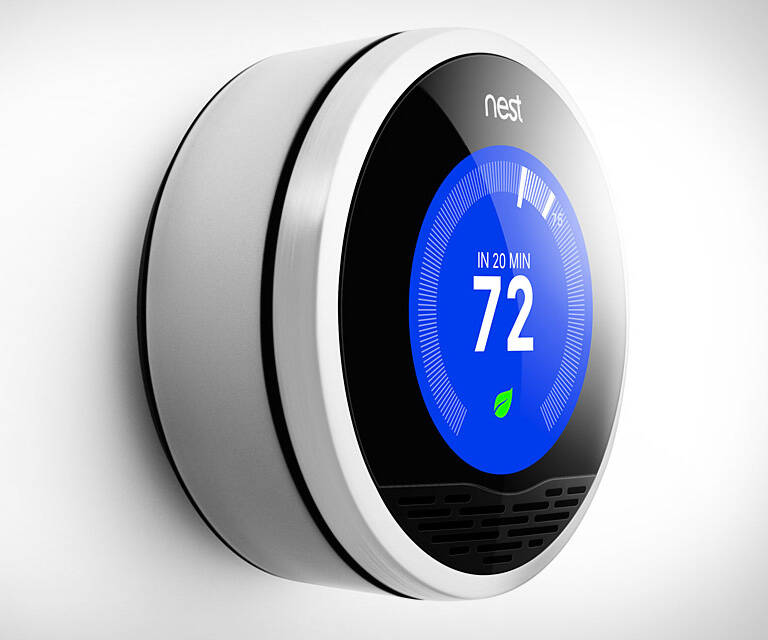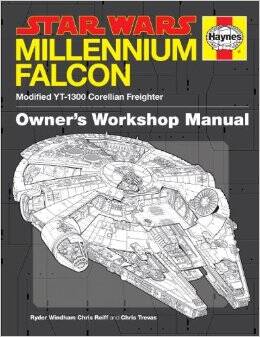Learning Thermostat | |||||||||||
| |||||||||||
Product Description
The 2nd Generation Nest Learning Thermostat has a new, slimmer design, is enclosed by a solid stainless steel ring, and works with 95% of low voltage systems. The Nest Learning Thermostat learns what temperatures you like, turns itself down when you're away and can be controlled from anywhere over Wi-Fi. By programming itself, the Nest thermostat can save up to 20% on your heating and cooling bill. You just have to teach it well.Features
- Works with Alexa for voice control (Alexa device sold separately).
- Nest saves energy by automatically turning itself down when you're away
- 2nd generation design - nest is now 20-percent thinner and works in 95-percent of homes with low Voltage systems
- Auto-Away: Nest saves energy by automatically turning itself down when you're away
- Auto-Away: Nest saves energy by automatically turning itself down when you're away
- Auto-schedule: Remembers the temperatures you like and programs itself. Easy install - most homeowners install nest themselves in 30 minutes or less. After that, it's just a matter of changing the temperature
- 2nd generation design: Now 20-percent thinner and works in 95-percent of homes with low Voltage systems
- Remote control: Connect Nest to Wi-Fi to control it from your smartphone, laptop or tablet
- Works with 95% of 24V heating and cooling systems, including gas, electric, forced air, heat pump, radiant, oil, hot water, solar and geothermal. Heating: 1,2, and 3 stages (W1, W2, W3) Cooling: 1 and 2 stages (Y1, Y2) Heat pump: with auxiliary and emergency heat (O/B, AUX, E) Humidifier or dehumidifier (HUM, DEHUM) Fan (G) Power (C, RH, RC)
- Works with Alexa
Top Reviews
Has a tremendous amount of potential, but can't recommend in current stateby cd2000 (1 out of 5 stars)
December 17, 2013
I'm an HVAC contractor who's installed and troubleshooted this product in customer's homes for the past couple years and experienced the good, the bad, and the ugly. Let's start with the good.
Pros:
-It looks great. Personally I don't really care what my thermostat looks like but I know that is very important to many people and the Nest is unmatched in this area.
-When it works, it is hands down the easiest thermostat to install. The ability to sense wires and automatically configure the thermostat is a cool feature you don't see too often. They have a nifty wizard on their website that where you check the wires you have and it figures out what type of system you have and whether or not it will be compatible. Not that I really care, since this is what I do for a living, but for DIYers who have never done something like this before, it's nice.
-In theory, it can control quite a wide range of HVAC systems, including 4 stages of heating, 2 stages of cooling, dual fuel systems, and humidification/dehumidification.
-The customer service reps do genuinely seem to want to help, and there have been cases of them giving refunds even outside of the return period, or paying for visits by HVAC contractors to troubleshoot issues or repair damage caused by the thermostat.
-The auto away and auto learning seem to work as advertised for the most part and IF, a big IF, you didn't program your previous thermostat, they will save you energy. However your money would be put to much better use by spending 10 minutes reading the manual of your traditional thermostat and programming it (even if its unintuitive, it's not something you have to do often). Then, take that $250 and put it towards something that will REALLY save energy, such as tightening up your house.
-It has energy reporting which the Honeywell wifi thermostats lack (although the Honeywells are better thermostats in every other regard)
Cons:
-Reliability has been less than satisfactory. Instead of using good old reliable relays like most thermostats Nest decided to use what they call FETs (Field Effect Transistors) to control the equipment. They probably did this so they could give the thermostat its small form factor. Unfortunately, they aren't so reliable and tend to fail in the on position. The Y terminal (compressor) seems to fail pretty frequently causing A/C to run in the winter, sometimes at the same time as the heat. Some people do not have this issue, but for those that do, it seems to happen again and again no matter how many new baseplates Nest sends out. IMO it doesn't matter how many people don't have issues, the technology is plain unreliable and they need to stop using it. Besides the FET issue, software updates are pushed to the thermostat and the user has no choice on whether or not to accept them. Sometimes, they have bugs. The most recent one, 4.0, which the only purpose of was to add support for the Nest Protect, caused issues with some thermostats unable to power themselves. Some Nest owners found their thermostats unable to connect to wifi. Others found their pipes frozen as the Nest failed to turn on their equipment. Again, not everyone had an issue. But a thermostat is not an iPod. A buggy update is going to cause a much bigger problem than being without your music if you are part of the group that does have problems. They need to stop forcing updates on people (have a way to apply them at will) and test them extensively on their own systems before release.
-It's a power stealing thermostat. One big issue when you upgrade to any wifi thermostat is how to power it. To understand this issue, I will give a brief history of thermostats. Back in the old days, we had simple mercury thermostats. No need to power them at all! But then along came digital programmable thermostats. They needed power for their displays, memory, and possibly a backlight. The most common HVAC system in US consists of a basic single stage gas furnace, matched with a single speed central air conditioner. To control this setup, you need four wires in your wall going to your thermostat. This worked fine for old mercury thermostats. To actually enable the thermostat to power itself, though, you need a 5th "common" wire. But, most people only had 4 wires going to their thermostat location. Programmable thermostat manufacturers came up with two solutions to this. The most common solution was to make the thermostats battery powered. These were simple enough to install and worked fine, the only con was that you had to replace the batteries periodically. Another solution was called a "power stealing" thermostat. This thermostat robbed enough current from the HVAC control wires to power itself, but NOT enough to trigger the HVAC system. On older HVAC systems that just ran off relays, this worked fine. Fast-forward to the age of wifi thermostats. How to power these things? AA Batteries wouldn't work, because the wifi drew too much power. What MOST wifi thermostat manufacturers decided to do was FORCE customers to run a common wire to power the thermostat. Nest was not satisfied with this as they wanted to make their thermostat easy to DIY install, so they decided to implement power stealing. Nowadays, though, most HVAC systems run off control boards, which are often sensitive to attempts by a thermostat to rob power for itself and may not let it at all. So sadly, the Nest actually works better with old standing pilot furnaces than newer efficient ones, even though it is a thermostat that promotes efficiency. Huh? Luckily, Nest gives you the option to connect a common wire if you have one, so you don't need to rely on the power stealing. Unfortunately, this issue has just led to too many problems and too much confusion by consumers who thought that Nest would work with their system and then found they needed a common wire. As you can see, not everyone will experience issues, but enough will that it is not OK to assume it will just work, and also it is possible for problems to occur even if it has been working for a long time due to changes in weather and battery capacity.
-"Heat Pump Balance" DOES NOT work as advertised and not only will it not save energy, it will use MORE by running backup aux heat way too much. You can turn that off and set your own lockout temperature for aux heat, but the minimum is only 35 degrees. Most modern heat pump systems can hold their own own down into the 20s. THIS IS A REALLY BAD BUG, IT AFFECTS ALL HEAT PUMP USERS. BE WARNED!
-It doesn't run multistage systems properly. If the Nest detects 1st stage is not keeping up, it will kick into 2nd stage. Fine, most thermostats do this. But then, instead of dropping back into 1st stage, it will stay in 2nd until it shuts off, decreasing comfort and efficiency. Finally, when recovering from a setback, it will ONLY use 1st stage, which takes way too long and makes it difficult to recover in time.
-Technical support isn't so great. Lately there have been ridiculously long hold times, and they don't seem to know what they're talking about. They are polite and professional, though, and I don't blame this problem on the agents, I blame it on the fact they aren't trained properly, which has to do with the next con...
-The overall attitude of the company. They do not communicate with their customers adequately to alert them of updates or problems. There is a community forum on their website that is quite helpful, and I highly recommend you visit it before purchasing. There used to be Nest moderators there, but they have all but abandoned it. There are many Nest users there though who put a lot of time into helping people solve problems and giving advice on how to best use Nest products. There are many complaints there, but they aren't "bashing" the products. Instead they give constructive criticism to Nest on where to improve, and ask for basic updates on what Nest is doing and whether they will fix these numerous issues. Unfortunately, instead of responding to the community members, they decided to make it un-indexable by search engines so prospective customers would NOT see this information. You can see for yourself. Go to [...] and view the source code of the page. You'll see . You can click "recent discussions" to see what people have been posting and feel free to create an account and ask any questions you may have.
-No adjustable temp swing or cycles per hour (other than selecting between radiant and forced air heat)
-Can't adjust % RH setpoint for humidifier automatically based on outdoor temperature
-Their implementation of emergency heat for heat pumps doesn't work well with the majority of systems installed (see the comments thread for more detail).
-The energy reporting is kind of lame. It pales in comparison to Ecobee. Not enough cold, hard, data and too many meaningless statistic like "leaves".
-No hold mode. Really guys, $20 programmable thermostats have this.
Conclusion: Would I recommend this product? Not currently I wouldn't. If you have a heat pump or multistage system, I absolutely would not recommend it. If you have your heart set on this thermostat and have a basic single stage system, be prepared that it may not work without a common wire, and be prepared for the possible reliability issues. Watch it closely after you install and be ready to return it within the 30 day period if necessary. And really, not even considering the reliability issues, is it worth it? I'm not convinced.
UPDATE 1/13/14: Nest has released a new version of their software, version 4.0.1, which claims to have all the new features of 4.0 but the performance of 3.5.3. The jury's still out on whether it does what they say it will: some people are reporting different issues they didn't have before, others say it fixed their issues. The good news, though, is that there is now a moderator on the Nest community, Brian, who is answering people's questions and helping them get the updates they need. While they still have a long way to go, it is good to see them moving in the right direction. Also, for those who don't know: Google owns Nest now. Make of that what you will, I won't comment on the privacy since everyone has a different opinion on that, but I am optimistic that the Google acquisition will accelerate the development of the product.
Stopped Working Just After Warranty and Will NOT Heat My Home
by Captain Morgan (1 out of 5 stars)
January 24, 2018
I've had this Nest thermostat for a few years with no issue. That was until I tried to turn on the heat yesterday. Only cold air came out.
I assumed it was the heater and fast forward $300 later, I learn my heater is fine.
Now, after speaking with Nest tech support, I've learned it's a "software defect" in the unit. And the unit's 2-year warranty expired in July... They best they can do is offer me 20% off my next Next product....
Unbelievable. The agent believes its an issue with the Nest unit...which is now a paperweight. There's literally no way to even manually override the Nest and turn on the heat. I guess I'm getting either an Ecobee or Honeywell now.
The Away mode no longer works the way it used to work for the past 4 years.
by AShop76 (1 out of 5 stars)
January 27, 2017
While I've enjoyed the nest thermostat for the past two years that I've owned it, I was in for a bitter shock when the "Away" feature no longer worked and kept my home furnace running while I was away on vacation for two weeks. Nest changed the functionality of this most basic feature without any heads-up or updating the published documentation.
It used to be that I would go into the app and change the thermostat status from HOME to AWAY, which would change the temperature settings to ECO settings that I had configured, overriding the scheduled temp settings.
With recent software update, the "Away" feature no longer works as advertised. The software kicks the thermostat our of Away mode (eco settings) if the schedule calls for a temperature change, defeating the purpose of Away mode.
Nest support admitted to me that the recent software changes have not gone well with customers and the changes were released without proper updates to the literature, however, they had to change the Away feature functionality/definition to support other products they offer.
Needless to say, I'm disappointed with Nest for releasing half baked software without proper communication with existing customer, costing me a higher utility bill for the two weeks I was away.
The bloom is off the rose... Run, don't walk, away from the Nest thermostat
by Curt Kohler (1 out of 5 stars)
July 5, 2014
I purchased my 2nd generation Nest in February of 2013 and installed it on my 9 year old A/C and Gas furnace. It was a newer house and had a common wire available so I had no issues needing the unit to steal power that many were complaining about on the forums and reviews. At first I loved it, its sleek lines, the ability to tweak temperatures from my phone while away, the cute little Leaf reports every month. What was not to like? I was under the spell of Nest's marketing and design. All was good in the land of heating and cooling at my house. However, the relationship started to go sour in under a year. The Nest engineers started giving me unannounced, surprise presents in the form of software updates that I had no choice in accepting. Suddenly my previously solid Nest started dropping my home WiFi making it unreachable remotely. Of course it must be an issue with my wireless router not properly supporting the standards (never mind that it worked flawlessly for 6 months). Now when my wife asked me to change the heat/air in the middle of the night I got to walk downstairs to do it. Truly deja vu.
Now fast forward another 8 months. I come home on a Saturday afternoon in mid-June from my son's baseball game and the house seems a bit warm. As the day progresses, the temperature continues to rise. When I look at pretty Nest display I see an error message E24 No power to Rh detected. Playing around I find that nothing on my HVAC system is working (A/C, Heat, blower). A call to my friendly HVAC service company determines that the transformer in the furnace has blown. No problem I say, transformers can get old and break. They put on a new one and it immediately fries as well. Further investigation shows heat damage on the controller board as well. I get the quote to fix all the electronics and compare with the cost of a new high efficiency furnace with a 10 years parts&labor warranty and decide to bite the bullet and replace the furnace. They hook up the wires and everything starts humming as expected. All is again good in the land of heating and cooling and I can go out of town on business safe in the knowledge that my family will be comfortable with my new furnace/circuit board and Nest thermostat.
Fast forward 7 days. I'm back from my trip and in the basement. I notice that the A/C lines are dripping water and the evaporator coils are iced up. I turn off the system at the thermostat and shortly later notice the outside compressor is still running. I'm not an HVAC expert, but don't understand how that can be. I turned off the thermostat and everything should be off. I throw the breaker on the unit and call the HVAC company and give them an earful. Obviously something was not connected properly on the install or they didn't find the correct problem. Another tech comes out to diagnose the problem. As he enables the thermostat (breaker still off) we hear a loud buzzing coming from the contactor in the A/C unit. He turns off the thermostat again and swaps in a new part, but to his surprise the contactor starts to pull closed as he connects the wire. Did you turn the 'stat on again he asks me? We go and confirm the Nest is still turned off and then head for the basement to confirm the wiring in the furnace again. Putting the multimeter on the board we see the the A/C is still getting a call for cooling even though everything is turned off upstairs. The tech then says the words I can't believe: "Looks like the thermostat is causing the problem" I ask: "Could that be the cause of all the damage to the old system over the past 2 weeks?" "Very well could be." he tells me. I still have my old Honeywell thermostat from 18 months ago. We hook it up and the A/C and furnace immediately start behaving as expected. "Damn you Nest!!!". You lured me in like a fool and now you've trashed my system and cost me quite a bit of money.
That evening searching on Google and the Nest forums, I start to find quite a few complaints about Nest running the A/C continually due to the components in the backplate shorting out. Search for some combination of: Nest Backplate short Y1 FET. You'll find the threads. Please read them before you buy. Remember, the purpose of a thermostat is to regulate the temperature in your house as well as be reliable. Don't fall for the form over function trap that Nest is laying for you. I find it kind of ironic that Google who now owns Nest is indexing it all.
I'll be reaching out to Nest shortly to see what they have to say and if there is any willingness to help offset some of my expenses. I'm not holding my breath, but what do I have to lose? If not, I'm saving my bills and info and waiting for the inevitable class action suit that will be coming. I will update my review when I get my reply from Nest.
Don't buy it - it'll break and then you are in for the real fun of dealing with them
by MJK in AZ (1 out of 5 stars)
March 27, 2018
I bought a couple of these in 2015, and until recently everything worked as advertised.
A couple weeks ago, I come home to both the gas heat and the electric A/C running continuously. Nothing in the Nest prevents this behavior, even swapping my 2 units. So, a problem with the HVAC controls then right? Call an HVAC tech who says my blower control board is bad. Ok, new one installed but problem persists. Huh. The company 'specialist' is required. A week later he shows up.
It is determined that the Nest's base plate is bad. Swapping them moves the problem. After an HOUR in chat with Nest they tell me that if my unit were under warranty (it isn't) that they could send me one for free, but because it is out of warranty they won't sell me one. When I ask why not then I get an 'escalation agent', oops connection lost. So, after a 22 minute phone call they have managed to locate my case again and get back to a senior advisor who informs me that 'yes, this is a known issue. We have the base you need. We won't give you or sell you one. Yes we hope you buy another $250 thermostat, and if it dies after 2.5 years like this one did you'll be screwed again'. Unbelievable!
I've got about $1000 worth of Nest products. "Hey Google! Guess who will never get another dime of my money?"
Check for the blue wire - you'll need it even if the NEST wiring guide says you don't
by Garrius (4 out of 5 stars)
July 7, 2015
Pro's:
- Simplicity
- Remote control from your phone
- Beautifully designed piece of equipment
- Excellent 24/7 tech support from folks in the good old USofA
- NEST volunteered to pay up to $300 to have a common wire installed between my NEST and furnace - not sure how they make money on installs like mine but the gesture was appreciated
Con's:
- Even though the wiring diagrams and literature say that you don't need a common wire (blue), you really do unless you want your AC compressor to stay off
- Installation took several hours of troubleshooting over two days
Synopsis:
I've FINALLY got my nest installed and it's working fine. One word of advice - make sure you have a five wire, low voltage system before buying (you really do need that common blue wire). If you don't, the NEST will keep drawing power from your RC or RH connection, and cause issues with your HVAC. In my case the AC would turn on but the compressor would not - essentially turning my system into a really inefficient fan. In my case there was a blue common wire run to the furnace but it was not connected on the printed circuit board or my original thermostat. A fairly simple fix once you know what the issue is and if you have done work as a electronics technician in a prior life.
Overall, I am content on day three with my NEST because of the excellent support, willingness to reimburse me to have a pro come out to install the device and quality of product. This would have been a five star review if the NEST folks had just been upfront about needing the common wire in the setup. It's nice of them to offer to pay for someone after the fact but it's still a time issue. There are MANY folks who have experienced the fifth wire problems guys - it's time to own up to this in your installation guide.
I will provide an update in the future when I have more experience with the NEST thermostat in action.
1) Nest is like all thermostats in that perceived temperature has nothing to ...
by Mark M. Bernheim (1 out of 5 stars)
December 29, 2017
I'm kind of hating Nest.
1) Nest is like all thermostats in that perceived temperature has nothing to do with the reading.
2) Los Angeles building code is stupid because a thermostat has to be withing so many feet of a register. This only means that the space you live in and the location of the thermostat have even less in common.
3) Nest thermostats are pretty.
4) All of that being said, this "smart thermostat" crap is garbage. I set it to 80 degrees because it is freezing, the house is under construction and there are drafts. Five minutes later Nest rests to 64 degrees in the middle of winter.
5) Programming this thing is like cracking a safe. Two turns to the right. Three turns to the left. What a joke.
6) By the way, I have two of them.
Read before buying.
by Myron Thornberry (1 out of 5 stars)
November 6, 2013
I REALLY wanted for this to work out well! And bring years of delight and accessibility. I have even advertised this to many friends, coworkers and vendors - many of whom purchased the item. But now, one year later, I must admit defeat and disappointment. I purchased (2) Nest-2 thermostats last year as soon as they became available. Both to be Christmas presents: one for parents, one for sister and her family. To be brief and summarize:
My parents were unable to install themselves and had to hire "the furnace guy" to do the install. During the winter they were having furnace problems and needed to rely on "booster heat". The nest was not capable. So Dad had to conference call nest and get walking through rewiring the nest to get essential heat. Fail. Dad paid the furnace guy to remove the nest after 2 weeks of that.
My sister was able to install her nest by herself but found it incredibly frustrating. The temperature reading on the nest never matched all of the other thermometers in the house....all of which matched each other. So she had to set the nest 5 degrees off of the desired temperature in order to be comfortable. But she kept it up...until last week. The furnace stopped working. Her family was very uncomfortably cold for the long weekend until the furnace guy could come out. The furnace was fine. The nest was the issue. Fail.
So disappointing! $500 wasted. No delight. They added incredible frustration and discomfort to my family.
Very chic in many ways but as a thermostat, it is not so good.
by Just Jim,Top Contributor: Photography (2 out of 5 stars)
August 1, 2015
There are a lot of reviews here so I'll just state my main points and be gone.
Nest was easy to install since I had a "C" wire. It does jut from the wall more than most thermostats I've seen. I have to be sure to maneuver around it as I walk through the hall where it is installed. The temperature display sometimes reads 5 degrees higher than actual. Then, on next glance, it will have dropped down 3 degrees or so. Eventually it will coast to the right temp over a few hours but you never know when it will go nuts again. That is not helping my power bill at all. I've tried insulating the wall behind it but that did not help. Temperature control for cooling is not good. If I set the A/C for 78 the unit powers on at 79 and turns off at 77. The temperature just never feels right and I feel uncomfortable most of the time. My Honeywell thermostat allowed a tighter band and even had a feature that would randomly kick on the fan to help even out the temp in the house. The difference in the "feel" of the properly conditioned living space is substantial and remarkable. Nest, with all its elegant fine points notwithstanding, is fundamentally a poor thermostat based on my experience living with it.
Furthermore, I've decided that I will not trust my system to the Nest. Since installing, I've read too many reports of failures of the solid state switches on the base plate. Many claim their A/C compressors or heaters were run continually or even at the same time. There seems to be a problem with this, but Nest does not address it nor provide encouraging words in support of this design. I have decided I did not need to spend all this money to buy a problem. I'm going back to my Honeywell. It is also Wi-Fi but has actual relays to control the components and not tiny solid state switches. Relays are more reliable, I think, and failures won't necessarily damage my system.
AVOID THE NEST or SUFFER THE CONSEQUENCES
by R. D. DEANGELIS (1 out of 5 stars)
March 18, 2015
I was a huge fan of the nest originally as the concept is great and the application worked well. I've bought three, two for home and one for my office. Unfortunately, I have had one of the two home units go bad and need to be replaced in the Summer in Phoenix and they replaced it for free which was great. At work, I have a two stage unit that just went bad on me and caused very costly damage in my high end two stage AC unit. The repair guys said that they see a lot of problems with the nest.
This Nest, which I've had for about a year and a half in my office condo caused my AC to breakdown costing me over $2,000 in repairs. Because the Nest unit was only putting out 14-16 rather than 24 volts, it caused a major malfunction in the switches and the each burned up. ($413 each X3) The repair guys insisted that I not put another Nest on because they see it was the cause of the failure/breakdown.
Customers Who Bought This Item Also Bought
- Google, NC2400ES, Nest Cam Outdoor, Security Camera, White, 2
- Google, T3019US, Nest Learning Thermostat, 3rd Gen, Smart Thermostat, Polished Steel, Works With Alexa
- Nest Cam Security Camera 3 Pack Indoor Color: Black Style: Nest Cam Security Camera: 3 Pack, Model: NC1104US
- Google, T3008US, Nest Learning Thermostat, 3rd Gen, Smart Thermostat, Pro Version, Works With Alexa
- Nest (T3007ES) Learning Thermostat 3rd Gen, Stainless Steel with Deco Gear 2 Pack Wifi Smart Plug
- Ring Video Doorbell with HD Video, Motion Activated Alerts, Easy Installation - Satin Nickel
- elago Wall Plate Cover Designed for Google Nest thermostat Wall Plate (Stainless Steel Color) - Compatible with Nest Learning Thermostat 1st/2nd/3rd Generation, Matt Finish [US Patent Registered]
- Google, T3007ES, Nest Learning Thermostat, 3rd Gen, Smart Thermostat, Stainless Steel, Works With Alexa
- Humble Abode Creations Nest Thermostat Wall Plate, 6 Inch Stainless Steel Cover Plate, Fits Generation 1, 2, 3, E Nests
- Tenergy LED Light Bulb, 9 Watts (60W Equivalent) A19 E26 Medium Standard Base, 5000K Daylight White Energy Saving Light Bulbs for Office/Home, 32-Pack, Non-Dimmable
*If this is not the "Learning Thermostat" product you were looking for, you can check the other results by clicking this link








